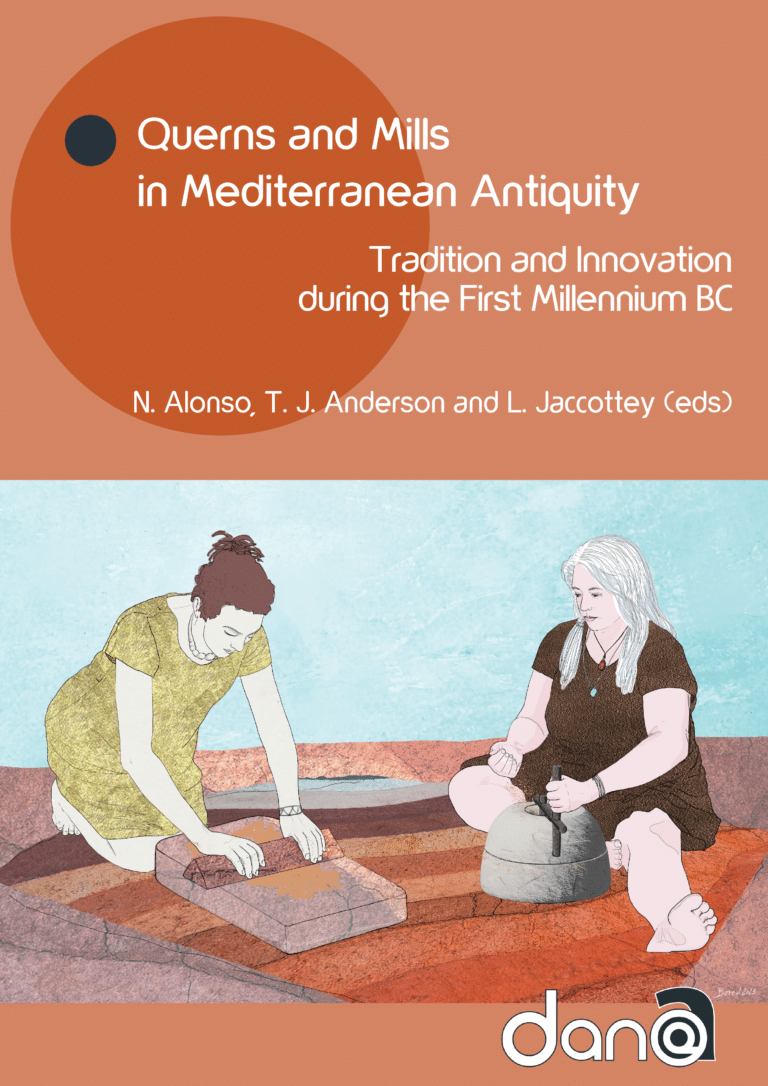The session Querns and Mills in Mediterranean Antiquity: Tradition and Innovation during the First Millennium BC was organised in the framework of the annual conference held in Barcelona (2018) by the European Association of Archaeologists (EAA). The intention was to take a first step in filling a key research gap concerning the subject of querns and millstones in a chronological and temporal timeframe where research is either sporadic or compartmentalised. Grasping the larger questions related to this subject in fact requires a broader approach englobing both the Mediterranean Basin and outlying areas, regions in full flux at the moment. This period also saw a series of key technical innovations, the most important being the introduction of the rotary movement to milling which not only led to a greater yield in a shorter period of time, but was a key contribution to the evolution of mechanics in general.
These proceedings therefore concern a specific sphere of molinological research still in its infancy that inevitably suffers from a number of growing pains. One specific issue worth highlighting is that it involves analyses carried out in different countries and languages (French, Flemish, Catalan, Spanish, German, English, Hebrew…). This explains the ‘cacophony’ and lack of consensus as to a series of key terms, notably quern, saddle quern, reciprocal mill, to-and-fro quern, back-and-forth quern, handstone, rubber, upper stone, lower stone, slab, table, loaf, hopper-rubber, Assyrian mill, Olynthus mill, millstone, hourglass mill, Morgantina mill, donkey mill, slave mill, Pompeiian mill …
Another lack of agreement is reflected in the most recent ancient milling survey by our dearly missed David Peacock. In his book The Stone of Life (2013) he retained the term ‘saddle quern’ to designate lower stones of mills driven manually with a to-and-fro motion. The term which stems from the concave shape of the lower stone (evoking a saddle) poses two problems. The first is that the original grinding surface of this stone was not concave but flat and the concavity only resulted from prolonged wear. The second is that use-wear and morphological research over the last two decades has revealed that certain ‘saddle-shaped’ querns identified as lower stones are in fact ‘overlapping’ (débordant) upper stones whose length surpasses the width of their lower counterpart. This is thus just another of the many issues symptomatic of ancient mill research that cannot be resolved at this time but that will hopefully be answered in the future.
Beyond these terminological questions, the study of protohistoric milling systems in the Mediterranean suffers from many spatial gaps. Although this publication includes studies from Israel, Greece, the south of France and the east and northeast of the Iberian Peninsula1, there remain vast extensions practically devoid of research. A case in point is Central Mediterranean, an area that is key to the understanding of the dynamics and evolution of the various types of mills during the 1st millennium BC. It is in fact in this timeframe that the Mediterranean saw the appearance and development of several new mill types, notably the Assyrian mill (Bombardieri 2008), the ‘molons’ of the Balearic Islands (Ferrer 2023) and a mill type with handle grips from the northeast of the Iberian Peninsula (Alonso & Frankel 2017; Alonso et al.; in this volume). Other novelties that appear to be geographically restricted to specific areas of France are upper stones bearing a slot (Georges et al. 2017) or a groove to insert a bar (Lagadec 2008). This particular period also saw a number of fittings serving to feed the grain into the mills. These innovations, simultaneous to the creation of more complicated driving fittings, were presumably due to the advent of specialised mill makers. Other types of upper stones, on the other hand, are found both in the eastern and western Mediterranean. This is the case of certain upper stones of triangular section (see Greener et al.; Eitam, Jaccottey et al.; Alonso et al. in this volume) that were probably introduced by commercial contacts, population movements and the presence of stonemasons capable of reproducing them. The notion of the circulation of specific quern types is likewise bolstered by the fact that the local mills from each extremity of the Mediterranean do not resemble each other and apparently stem from their own traditions (see Greener et al.; Eitam, Alonso et al.; Vives-Ferrándiz et al. in this volume).
In reality, the 1st millennium BC was characterised by contacts between different regions and cultures through the circulation of people, goods and ideas. And these contacts obviously also involved mills and raw materials (see Duchène; Alonso et al. in this volume). There is likewise an urgent need to move towards a global unified methodological approach to ancient mills in the Mediterranean, along the lines of the system of typological classification put forward by Chaigneau et al. for hopper-rubbers.
There is nonetheless hope that this subject of research will attain a sort of unified approach as there are in fact common factors such as manufacture standardisation, raw material choice, mill reuse, the difficulty in recognising passive grinding stones from active ones and their different types. Another issue shared by different areas is the introduction of new milling systems such as the hopper-rubber or the rotary quern.
It is well established that the innovation of rotary mill during this period represented a turning point in the history of the processing of cereals and other materials. Even so, there is still much to be learned as to the causes of its introduction and evolution, and the ensuing socioeconomic repercussions. The studies collected in these proceedings thus constitute modest but necessary advances in a vast and compelling field of research.
Bibliography
- Alonso, N. and Frankel, R. (2017): Survey of ancient milling systems in the Mediterranean, in: Les meules du Néolithique à l’époque médiévale: technique, culture, diffusion, Revue Archéologique de l’Est Suppl. 43, 461-478.
- Bombardieri (2008): The millstones and diffusion of new grinding techniques from Assyrian Mesopotamia to the Eastern Mediterranean Basin during the Iron Age, in: Monozzi, O., Di Marzio, M.L. and Fossataro, D. (eds), Proceedings of the IX Symposium on Mediterranean Archaeology, Chieti, February, 24-26, 2005, Oxford, 487-494.
- Ferrer Rotger, A. (2023): Actividades productivas en contextos domésticos de la segunda Edad del Hierro en Menorca: la industria macrolítica del Círculo 7 de Torre d’en Galmés (Alaior), Complutum, 34 (1), 155-176.
- Georges, V., Jaccottey, L. and Robin B. (2017): Les molettes à rainure: nouveaux indices sur le perfectionnement du matériel de mouture dans le bassin de la Loire à l’âge du Fer, in: Buchsenschutz, O., Lepareux-Couturier, S. and Fronteau, G., eds, Les meules du Néolithique à l’époque médiévale: technique, culture, diffusion, Actes du 2e colloque du Groupe Meule, Reims, du 15 au 17 mai 2014, 377-382.
- Lagadec, J.P. (2008): Les meules en rhyolite de La Salle (Vosges): typologie et diffusion. Antiquités nationales, 39, 129-139.




